

*Truth, truthiness, triangulation: A news literacy toolkit for a “post-truth” world. We were guaranteed a free press, We were not guaranteed a neutral or a true press.
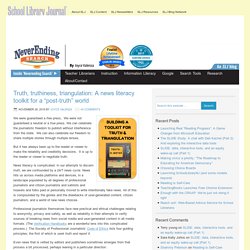
We can celebrate the journalistic freedom to publish without interference from the state. We can also celebrate our freedom to share multiple stories through multiple lenses. But it has always been up to the reader or viewer to make the reliability and credibility decisions. It is up to the reader or viewer to negotiate truth. *Why Do Our Brains Love Fake News? *RU515 Week 6 Infographics – Google Drive. *A News– and Media Literacy–Themed Mixtape for Tough Times. *News Literacy Must Include Social Emotional Learning. *SHEG Evaluating Information Online. Infographics as a Creative Assessment by Kathy Schrock.
Center for News Literacy – Bringing crucial critical thinking skills for the 21st century to teachers and students. News and Media Literacy: Building Critical Consumers and Creators. Photo Fact-Checking in the Digital Age. Teaching Digital Literacy. Presented by Michelle Luhtala, Head Librarian, New Canaan High School, CT; and Joyce Valenza, Assistant Teaching Professor, Rutgers University, MI Program Sponsored by Mackin Educational Resources If you attended the live session, you’ll be emailed a CE certificate within 24 hours of the webinar.
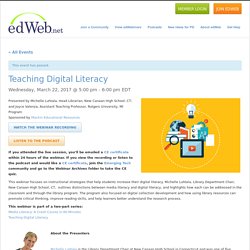
If you view the recording or listen to the podcast and would like a CE certificate, join the Emerging Tech community and go to the Webinar Archives folder to take the CE quiz. Lesson plan: How to teach your students about fake news. Fake news is making news, and it’s a problem.
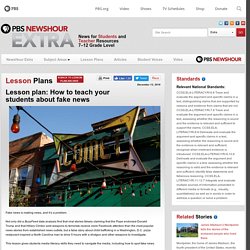
Not only did a BuzzFeed data analysis find that viral stories falsely claiming that the Pope endorsed Donald Trump and that Hillary Clinton sold weapons to terrorists receive more Facebook attention than the most popular news stories from established news outlets, but a false story about child trafficking in a Washington, D.C. pizza restaurant inspired a North Carolina man to drive 5 hours with a shotgun and other weapons to investigate. This lesson gives students media literacy skills they need to navigate the media, including how to spot fake news.
Subjects Social studies, U.S. government, civics, journalism Estimated Time One 50-minute class Grade Level Introduction. Mind Over Media: Analyzing Contemporary Propaganda. Media Literacy Clearinghouse. UW iSchool: Calling Bullshit 9.2: Fake News Definitions and Examples. UW iSchool: Calling Bullshit 9.3: The Ecology of Fake News. The Problem with Fake News (and how our students can solve it) Crap Detection 101. Howard Rheingold: Check Facts With Crap Detection Resources - DML Central. Want to know if someone plagiarizes a speech?
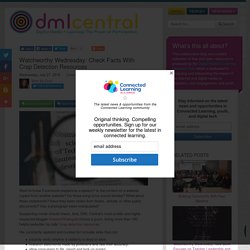
Is the content on a website copied from another website? Do those song lyrics sound familiar? What about those statements? Have they been stolen from books, articles or other public documents? Critical readers in the (mis)information age. Did you know that Chicago was the most dangerous city in the US in 2014?
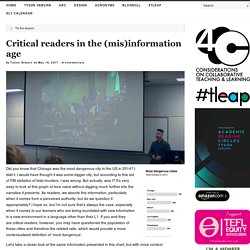
I didn’t. I would have thought it was some bigger city, but according to this set of FBI statistics of total murders, I was wrong. But actually, was I? It’s very easy to look at this graph at face value without digging much further into the narrative it presents. As readers, we absorb this information, particularly when it comes from a perceived authority, but do we question it appropriately? Let’s take a closer look at the same information presented in this chart, but with more context.
On the right (and “right”) are similar murder stats but put into the context of population. News and Media Literacy: Building Critical Consumers and Creators. Presented by Kelly Mendoza, Senior Director of Learning and Engagement, Common Sense Education Hosted by Common Sense Education and Sponsored by Symantec If you attended the live session, you’ll be emailed a CE certificate within 24 hours of the webinar.

If you view the recording and would like a CE certificate, join the Digital Learning & Leadership community and go to the Webinar Archives folder to take the CE quiz. Turn Students into Fact-Finding Web Detectives. Fact-Checking Tips and Tools for Teachers and Students Show students where to look for credible information on the web.
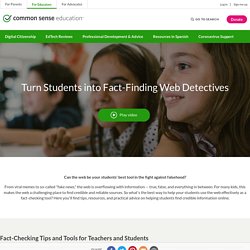
Explain that professional fact-checkers may already have done this important work for us. Use the resources below as references for finding vetted and fact-checked information. Common Sense Education. Renee Hobbs @ UN. MediaLit Moments. Friday, 19 May 2017 11:06 Beth Thornton In the “olden days,” people primarily relied upon newspapers for their news, and the papers were clearly labeled by section -- “News” “Features” “Opinion.”

Through everyday use, newspapers trained their readers to expect the international and national news on the front page, and state and local news in following pages, and to flip through the pages for articles about local heroes or topics of interest like Home and Garden, Sports, or their favorite columnists and Editorials. Today, such labels are abandoned when articles are lifted as links and shared via social media, or when people check YouTube for the latest news, or when people accept their friends’ postings as “news.”
When you read your news on Facebook (and many people do!) You are not alerted to the genre of the story, and it’s often hard to tell which category the story may fit. Allsides: Curating diverse perspectives (or looking at news from most sides now) Fighting Fake News: Can Technology Stem the Tide? School Librarians Are Teaching Digital Citizenship. April Wathen photo: Jill Springer April Wathen, Kathy Lester, and Steven Yates.
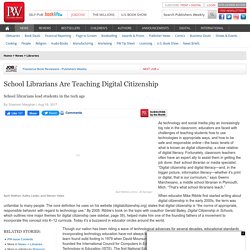
As technology and social media play an increasingly big role in the classroom, educators are faced with challenges of teaching students how to use technologies in appropriate ways, and how to be safe and responsible online—the basic tenets of what is known as digital citizenship, a close relative of digital literacy. Fortunately, classroom teachers often have an expert ally to assist them in getting the job done: their school librarian or media specialist. The Revenge of the Filter Bubble: How Accelerating Content Customization and Mobile Device Access Drives Fake News. Did Media Literacy Backfire? – Data & Society: Points. Update: On March 9, 2018, I gave a talk expanding on my ideas in this post after a year of reflection/research.
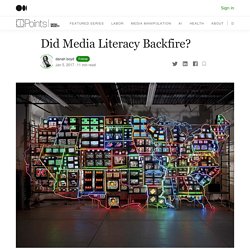
You can read the talk crib and watch the video at here: “You Think You Want Media Literacy…. Do you?” MediaBreaker Critical Remix Tools - The LAMP. Break-a-thons are short-term programs with The LAMP, and a perfect introduction for youth about how, why and for whom media are made. Each Break-a-thon focuses on a theme, like the Super Bowl, the MTV Video Music Awards, movie trailers or political advertising; youth then come together for one or two days to break media related to the theme. Participants compete in challenges throughout the event, win prizes and create their very own broken videos talking back to mass media. Past students tell us they never watch TV in quite the same way once they’ve done a Break-a-thon!